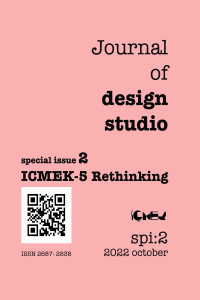The Instrumentalization of Fictional Narrative in Relation to Architecture-Urban Environment: The Example of “Laughable Places” Workshop
The Instrumentalization of Fictional Narrative in Relation to Architecture-Urban Environment: The Example of “Laughable Places” Workshop
Literature, Architecture, Creativity, Workshop, Representation Design,
___
- Argus x Writing Place:Space Time/Narrative. (n.d.). ARGUS. Retrieved April 15, 2021, from https://www.argus.cc/argus- x-writingplace-space-%C2%B1-time-narrative/.
- Bachelard, G. (1996). Mekanın poetikası. İstanbul: Kesit.
- Bakhtin, M. M. (1981). The dialogic imaginations: four essays. Austin, Texas: Texas University Press.
- Barthes, R. (1986) Semiology and the Urban. In M. Gottdiener and A. Lagopoulos (Eds.). The City and The Sign: An Introduction to Urban Semiotics (pp. 87-98). New York : Columbia University Press.
- Barthes, R. (2018). Yazarın Ölümü. Retrieved April 15, 2021, from https://oggito.com/icerikler/yazarin- olumu/8913
- Bekdaş, H. D. (2018). Conceptual thinking at the intersection of art and design: Informal education studies (2009- 2015). Megaron / Yıldız Technical University, Faculty of Architecture E-Journal, 13(2), 324-333.
- Charley, J. (2012). The Routledge Companion on Architecture, Literature and The City. London: Routledge.
- Chatman, S. B. (2009). Öykü ve Söylem: Filmde ve Kurmacada Anlatı Yapısı. Ankara: De Ki.
- Celik, P. Y., & Aydinli, Y. (2007). Creativity in design education: From problem-solving to puzzle-solving. ITU A|Z, 4(2), 38–51.
- De Certeau, M. (2008). Gündelik Hayatın Keşfi. Ankara: Dost Kitabevi Yayınları.
- Eagleton, T. (1996). Literary Theory: An Introduction. Oxford: Blackwell.
- Eagleton, T. (2015). Edebiyat Nasıl Okunur. İstanbul: İletişim.
- Eco, U. (1995). Anlatı Ormanlarında Altı Gezinti: Deneme. İstanbul: Can Yayınları.
- Fludernik, M. (2009). An Introduction to Narratology. London: Routledge.
- Gerards, S., & De Bleeckere, S. (2014). Narrative Thinking in Architectural Education. ARCC Conference Repository.
- Grafe, C., Havik, K. & Maaskant, M. (2006). Architecture & Literature, Reflections / Imaginations. Oase,70, 3-7.
- Gülmez, N. Ü., Yağan, D. A., Güney, E. E., & Şahin, M. (2020). Staging Poe: A narrative approach to Atmosphere in a first-Year design studio. Journal of Interior Design, 45(4), 11–32.
- Hasirci, D., & Ultav, Z. T. (2012). An Interdisciplinary approach to the design studio: Poetry as a Complementary Feature to the Creative Process. Procedia - Social and Behavioral Sciences, 51, 618–634.
- Havik, K. (2018). Writing atmospheres: Literary methods to investigate the thresholds of architectural experience. In J. Charley (Ed.). The Routledge Companion on Architecture, Literature and the City (pp.270-283). London: Routledge.
- Kimber, L. (2010). Truth in Fiction: Storytelling and Architecture [Master thesis, Victoria University]. Victoria University of Wellington, School of Architecture.
- Klein, J. (1990). Interdisciplinarity: History, Theory, and Practice. Detroit: Wayne State University Press.
- Kristeva, J. (1980). Desire in Language. New York: Columbia University Press.
- Laboratory of Literary Architecture. (n.d.). LabLitArch. Retrieved April 26, 2021, from http://lablitarch.com/.
- Lattuca, L. R. (2001). Creating interdisciplinarity: Interdisciplinary research and teaching Among. College and University Faculty. Nashville: Vanderbilt University Press.
- Leach, N. (2002). The Hieroglyphics of Space: Reading and Experiencing the Modern Metropolis. London: Routledge.
- Livesey, G. (1994). Fictional cities. In Pérez-Gómez, A. and S. Parcell (Eds.). Chora 1: Intervals in the Philosophy of Architecture (pp. 109-122). Montréal: McGill-Queen's University Press.
- Livesey, G. (2004). Passages: Explorations of the Contemporary City. Calgary: University of Calgary Press.
- Nazidizaji, S., Tome, A., Regateiro, F., & Ghalati, A. K. (2015). Narrative ways of architecture education: A case study. Procedia - Social and Behavioral Sciences, 197, 1640–1646. https://doi.org/10.1016/j.sbspro.2015.07.213
- Narrative Architecture. (2019,March 21). Archiford. Retrieved April 16, 2021, from https://www.archiford.com/2019/03/21/narrative- architecture/
- Nesbitt, K. (1996). Introduction. In K. Nesbitt (Eds.), Theorizing a New Agenda for Architecture - An Anthology of Architectural Theory 1965-1995. New York: Princeton Architectural Press.
- Pamuk, O. (2006). Istanbul: Memories of a City. London: Faber & Faber.
- Perez Gomez, A. (2012). Literary language and architectural meaning. In Charley J. (Eds.). The Routledge Companion on Architecture, Aiterature and the City (pp. 179-190). London: Routledge.
- Prince, G. (2003). A Dictionary of Narratology. Lincoln, NE: University of Nebraska Press.
- Ricoeur, P. (1979). The Human Experience of Time and Narrative. Brill. 9, 17-34.
- Ricoeur, P. (1984). Time and Narrative Vol. 1. Chicago & London: University of Chicago Press.
- Ronen, R. (1986). Space in fiction. Poetics Today, 7(3). 421-438.
- Sebald, W. G. (2006). Satürn’ün Halkaları: İngiltere’de Bir Hac Yolculuğu. İstanbul: Can Yayınları.
- Sönmez, F. U. (2007). Mekanın Yazınsallığı ve Bir Taşkışla Deneyimi. Arredamento, 200, 53.
- The Laboratory of Literary Architecture (n.d.) LabLitArch. Retrieved April 15, 2021 from http://lablitarch.com/
- Walker, J. (2009). Defining the object of study. In (H. Clarks and D. Brody Eds.). Design Studies A Reader (pp. 42-49). Oxford, Newyork: Berg.
- Writing Architecture Through Fiction (n.d.) Architecture MIT. Retrieved April 15, 2021, from https://architecture.mit.edu/subject/iap-2018-iap-non-credit-0
- Yayın Aralığı: Yılda 2 Sayı
- Başlangıç: 2019
- Yayıncı: Orhan HACIHASANOĞLU
Dialogical Structure Experience in Basic Design Studio at Online Education
Zobo Tea Package Design Prototype Allied with Product Onomastics
Ayorinde OLUYEMİ, E. Bankole OLADUMİYE, Oluwafemi S. ADELABU
Hapticity in Digital Education Atmospheres
Esen Gökçe ÖZDAMAR, Gökçen Firdevs YÜCEL CAYMAZ, Hülya YAVAŞ
Bülent ÜNAL, Hatice Merve DEMİRCİ, Emrah DEMİRHAN
